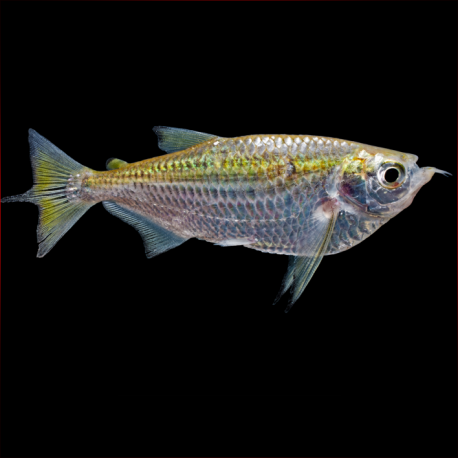More info
Datasheet
| Minimum Tank Size | 110 litres / 29.06 US gallons |
| Maximum Size | 16.5cm / 6.50inches |
| Temperature | 22°C / 71.60°F - 30°C / 86.00°F |
| Hardness | 0-20ºdH |
| pH | 5.0-7.5 |
General Description
The Dusky Narrow Hatchetfish (Triportheus Angulatus) is an eye-catching yet uncommon species in the aquarium trade. With its native name being sardina, this fish boasts robust pectoral muscles allowing it to leap out of the water to catch flying insects or evade threats, exhibiting impressive jumps of several meters in length. It can reach a maximum size of 16.5cm.
Aquarium Setup
When setting up an aquarium for the Dusky Narrow Hatchetfish, a minimum tank size of 110 liters is recommended. Providing ample surface area rather than depth is crucial as this species predominantly stays just below the water surface. The tank should include floating vegetation to reduce its skittishness, and well-oxygenated water. Securing a tight-fitting lid is essential due to their remarkable leaping ability.
Behaviour
While generally peaceful, the active nature and adult size of the Dusky Narrow Hatchetfish may disrupt smaller or quieter tankmates. It thrives in shoals and pairs well with South American cichlids like Geophagus and Satanoperca species. This species, being a natural shoaler, should always be kept in a group for its well-being.
Feeding and Diet
Being omnivorous, the Dusky Narrow Hatchetfish feeds on various food sources like insects, fruits, nuts, and seeds in its natural habitat. In captivity, it readily accepts a diet comprising live, frozen, and dried foods. Notably, this species predominantly feeds from the water surface.
Reproduction & Dimorphism
Reproduction of the Dusky Narrow Hatchetfish in aquarium settings has not been documented. Details regarding sexual dimorphism are currently unknown, warranting further research in this area.
Habitat and Distribution
In the wild, the Dusky Narrow Hatchetfish inhabits river channels above sandy substrates, commonly found in regions including Ecuador, Venezuela, Peru, Brazil, Bolivia, and Argentina. The species prefers swimming in shoals in such habitats. It thrives in well-oxygenated water with a pH range of 5.0-7.5 and temperatures between 22-30°C. Hardness levels should ideally be within 0-20°dH.

